The Use of PPGIS: Towards Reaching a Meaningful Public Participation in Spatial Planning
Abstract
:1. Introduction
1.1. Aim of the Research
- RQ1: What are the local authorities’ motivations for applying PPGIS in public consultations?
- RQ2: To what extent are the results of e-consultations using PPGIS tools used in the decision-making process?
- RQ3: Does the use of PPGIS increase the level of public participation in terms of citizens’ empowerment?
1.2. Power Relations in Spatial Planning
1.3. Assumptions of PPGIS
1.4. Formal and Legal Conditions of Public Participation in Poland
- Low attendance and insufficient representativeness of citizens;
- Low communicativeness (specialized content and language);
- Late participation of residents in the planning process;
- No real influence of residents on decisions;
- Limiting participation to a reaction on the decisions already made;
- Legal obligation to carry out public consultations instead of dialogue and negotiations;
- Bringing stakeholders into confrontation, generating tensions among the participants of the planning process.
2. Materials and Methods
2.1. Research Design
- How did you intend to use the geo-questionnaire results in your work?
- What impact did you expect on the work of entities responsible for the preparation of the plan?
- What kind of public opinion about the used method did you expect?
- What was the motive for the decision to use the tool?
- Were the potential conflicts in the planning process significant while making a decision to use this method?
- What were the main dilemmas/problems related to the content of the project?
- Did the geo-questionnaire data help to solve these dilemmas?
- Did the data obtained during the consultations influence the decisions made? (If not, why not?/If so, which data?/If so, which decisions?)
- Was the data collected through the questionnaire useful during the work on the project?
- Which elements of the results were, in your opinion, most useful?
- Did the data help to better understand the needs, perspectives or attitudes of the participants in the consultation?
- Did the data influence your opinion on the content of the project?
- Would it be possible to obtain such data in other ways?
- What were the benefits of using the tool?
- Did the tools generate any additional difficulties/concerns/costs?
- Were the benefits greater than the costs in your opinion?
2.2. Selected Cases
3. Results
3.1. Motivations for Applying PPGIS in Spatial Planning
3.2. Stakeholders’ Design Expectations and the Evaluation of Decision-Making Output
3.3. The Rrole of PPGIS in Citizens’ Involvement in Decision Making
- The initial stage of the process (before the initiation of public consultation);
- The final stage of the process—carried out behind closed doors (between decision makers, urban planners, and landowners) and/or with the use of statutory forms of public consultation only, thus excluding the wider participation of residents.
4. Discussion
5. Conclusions
Author Contributions
Funding
Institutional Review Board Statement
Informed Consent Statement
Data Availability Statement
Acknowledgments
Conflicts of Interest
References
- Healey, P. Institutionalist analysis, communicative planning, shaping places. J. Plan. Educ. Res. 1999, 19, 111–121. [Google Scholar] [CrossRef]
- Izdebski, H. Nowe kierunki zarządzania publicznego a współczesne kierunki myśli polityczno–prawnej. In Nowe Zarządzenie Publiczne i Public Governance w Polsce i w Europie; Bosiacki, A., Izdebski, H., Nielicki, A., Zachariasz, I., Eds.; Liber: Warsaw, Poland, 2010; pp. 12–27. [Google Scholar]
- Izdebski, H. Samorząd Terytorialny. Podstawy Ustroju i Działalności; LexisNexis: Warsaw, Poland, 2011. [Google Scholar]
- Quick, K.S.; Bryson, J. Theories of public participation in governance. In Handbook in Theories of Governance; Torbing, J., Ansell, C., Eds.; Edward Elgar Press: Cheltenham, UK, 2016; pp. 158–169. [Google Scholar]
- Banyan, M.E. Participation. In Encyclopedia of Governance; Bevir, M., Ed.; Sage Publications: Thousand Oaks, CA, USA, 2007; pp. 659–663. [Google Scholar]
- Bryson, J.M.; Quick, K.S.; Slotterback, C.S.; Crosby, B.C. Designing public participation processes. Public Adm. Rev. 2013, 73, 23–34. [Google Scholar] [CrossRef]
- Haughton, G.; Allmendinger, P.; Counsell, D.; Vigar, G. The New Spatial Planning: Territorial Management with Soft Spaces and Fuzzy Boundaries; Taylor & Francis: London, UK, 2010. [Google Scholar]
- Innes, J.E.; Booher, D.E. Reframing public participation: Strategies for the 21st century. Plan. Theory Pract. 2004, 5, 419–436. [Google Scholar] [CrossRef]
- Kingston, R.; Carver, S.; Evans, A.; Turton, I. Web-based public participation geographical information systems: An aid to local environmental decision-making. Comput. Environ. Urban Syst. 2000, 24, 109–125. [Google Scholar] [CrossRef]
- Denters, B. Participation and democratic accountability: Making a difference for the citizens. In The Future of Local Government in Europe Lessons from Research and Practice in 31 Countries; Schwab, C., Bouckaert, G., Kulhmann, S., Eds.; Nomos Verlagsgesellschaft: Baden-Baden, Germany, 2017; pp. 79–100. [Google Scholar]
- UNDP. Defining Core Characteristics of Good Governance. United Nations Development Programme, Management Development and Governance Division, Strengthening Capacity for People-Centred Development; UNDP: New York, NY, USA, 1997. [Google Scholar]
- Allmendinger, P. Planning Theory; Palgrave Macmillan: New York, NY, USA, 2009. [Google Scholar]
- Osborne, S.P. The New Public Governance? Emerging Perspectives on the Theory and Practice of Public Governance; Routledge: London, UK, 2010. [Google Scholar]
- Thomson, M. What’s so new about New Municipalism. Prog. Hum. Geogr. 2001, 45, 317–342. [Google Scholar] [CrossRef] [Green Version]
- Sagan, I.M. Nowa Kwestia i Nowa Polityka; Wydawnictwo Naukowe Scholar: Warsaw, Poland, 2017. [Google Scholar]
- Szczepańska, A. Procesy decyzyjne w gospodarce przestrzennej. Space Soc. Econ. 2009, 9, 43–51. [Google Scholar]
- Talen, E. Bottom-Up GIS: A new tool for individual and group expression in participatory planning. J. Am. Plan. Assoc. 2000, 66, 279–294. [Google Scholar] [CrossRef]
- Haklay, M.; Tabón, C. Usability evaluation and PPGIS: Towards a user-centred design approach. Int. J. Geogr. Inf. Sci. 2003, 17, 577–592. [Google Scholar] [CrossRef]
- Sieber, R. Public Participation Geographic Information Systems: A literature review and framework. Ann. Assoc. Am. Geogr. 2006, 96, 491–507. [Google Scholar] [CrossRef]
- Brown, G.; Kyttä, M. Key issues and research priorities for public participation GIS (PPGIS): A synthesis based on empirical research. Appl. Geogr. 2014, 46, 122–136. [Google Scholar] [CrossRef]
- Bąkowska, E.; Kaczmarek, T.; Jankowski, P.; Zwoliński, Z.; Mikuła, Ł.; Czepkiewicz, M.; Brudka, C. Geo-questionnaire in urban planning—Preliminary results of the experimental application in Poland. Rozw. Reg. I Polityka Reg. 2016, 35, 9–26. [Google Scholar]
- Jankowski, P.; Forss, K.; Czepkiewicz, M.; Saarikoski, H.; Kahila, M. Assessing impacts of PPGIS on urban land use planning: Evidence from Finland and Poland. Eur. Plan. Stud. 2021, 1–20. [Google Scholar] [CrossRef]
- Falco, E. Digital community planning: The open source way to the top of Arnstein’s Ladder. Int. J. E-Plan. Res. 2016, 5, 1–22. [Google Scholar] [CrossRef]
- Tulloch, D.L.; Shapiro, T. The intersection of data access and public participation: Impacting GIS users’ success? Urban Reg. Inf. Syst. Assoc. (URISA) 2013, 15, 55–60. [Google Scholar]
- Schlossberg, M.; Shuford, E. Delineating “public” and “participation” in PPGIS. Urban Reg. Inf. Syst. Assoc. 2005, 16, 15–26. [Google Scholar]
- Kaczmarek, T.; Wójcicki, M. Participation in public consultations on spatial planning documents. The case of Poznań City. Quaest. Geogr. 2016, 35, 71–82. [Google Scholar] [CrossRef] [Green Version]
- Ganapati, S. Using geographic information systems to increase citizen engagement. IBM Center for the Business of Government. Public Adm. Rev. 2010, 3, 425–434. [Google Scholar]
- Arnstein, S.R. A ladder of citizen participation. J. Am. Inst. Plan. 1969, 35, 216–224. [Google Scholar] [CrossRef] [Green Version]
- Wiedemann, P.M.; Femers, S. Public participation in waste management decision making: Analysis and management of conflicts. J. Hazard. Mater. 1993, 33, 355–368. [Google Scholar] [CrossRef] [Green Version]
- Dorcey, A.H.J. Public Involvement in Government Decision Making: Choosing the Right Model; Report of the B.C.; Round Table on the Environment and the Economy: Victoria, BC, Canada, 1994. [Google Scholar]
- Schapp, L.; Edwards, A. Local governance. In Encyclopedia of Governance; Bevir, M., Ed.; Sage Publication: Thousand Oaks, CA, USA, 2007; pp. 663–667. [Google Scholar]
- Flyvbjerg, B. Making Social Science Matter: Why Social Inquiry Fails and How It Can Succeed Again; Cambridge University Press: Cambridge, UK, 2018. [Google Scholar]
- Healey, P. Collaborative Planning. Shaping Places in Fragmented Societies; McMillan Press Limited: Hampshire, UK; London, UK, 1997. [Google Scholar]
- Taylor, N. Anglo-American town planning theory since 1945: Three significant developments but no paradigm shifts. Plan. Perspect. 1999, 14, 327–345. [Google Scholar] [CrossRef] [PubMed]
- Kahila, M.; Kyttä, M. SoftGIS as a bridge builder in collaborative urban planning. In Planning Support Systems: Best Practices and New Methods; Geertman, S., Stillwell, J., Eds.; Springer: Dodrecht, The Netherlands, 2009; pp. 389–412. [Google Scholar]
- Parysek, J.J. Wprowadzenie do Gospodarki Przestrzennej; Wydawnictwo Naukowe UAM: Poznań, Poland, 2007. [Google Scholar]
- Herbst, K. Partycypacja a prawo do miasta. In Partycypacja Społeczna w Planowaniu Przestrzennym; Urząd m.st. Warszawy: Warsaw, Poland, 2014; pp. 7–15. [Google Scholar]
- Simaõ, A.; Densham, P.J.; Haklay, M. Web-based GIS for collaborative planning and public participation: An application to the strategic planning of wind farm sites. J. Environ. Manag. 2009, 90, 2027–2040. [Google Scholar] [CrossRef] [PubMed]
- Masik, G. Neoliberalizm w polityce przestrzennej dużych miast. In Miasto w Dobie Neoliberalnego Urbanizmu; Szmytkowska, M., Sagan, I., Eds.; Wydawnictwo Uniwersytetu Gdańskiego: Gdańsk, Poland, 2012; pp. 211–221. [Google Scholar]
- Wójcicki, M. Formy i Zakres Partycypacji Społecznej w Procesie Planowania Przestrzennego w Poznaniu; Bogucki wydawnictwo Naukowe: Poznań, Poland, 2018. [Google Scholar]
- Burton, P. Power to the people? How to judge public participation. Local Econ. 2004, 19, 193–198. [Google Scholar] [CrossRef]
- Manzo, C.L. Beyond house and haven: Toward a revisioning of emotional relationships with places. J. Environ. Psychol. 2003, 23, 47–61. [Google Scholar] [CrossRef]
- Obermeyer, N.J. The evolution of public participation GIS. Cartogr. Geogr. Inf. Syst. 1998, 25, 65–66. [Google Scholar] [CrossRef]
- Brown, G. Public Participation GIS (PPGIS) for regional and environmental planning: Reflections on a decade of empirical research. URISA J. 2012, 24, 7–18. [Google Scholar]
- Mukherjee, F. Public participatory GIS. Geogr. Compass 2015, 9, 384–394. [Google Scholar] [CrossRef]
- Ganapati, S. Uses of public participation geographic information systems applications in e-government. Public Adm. Rev. 2011, 71, 425–434. [Google Scholar] [CrossRef]
- Panek, J. From mental maps to geoparticipation. Cartogr. J. 2016, 53, 300–307. [Google Scholar] [CrossRef]
- Parysek, J.J. Podstawy Gospodarki Lokalnej; Wydawnictwo Naukowe UAM: Poznań, Poland, 2001. [Google Scholar]
- Pánek, J.; Pásztó, V.; Burian, J.; Bakule, J.; Lysek, J. What is the current state of geoparticipation in Czech municipalities? GeoScape 2021, 15, 90–103. [Google Scholar] [CrossRef]
- Ghose, R. Politics of scale and networks of association in public participation GIS. Environ. Plan. A 2007, 39, 1961–1980. [Google Scholar] [CrossRef]
- Elwood, S.; Ghose, R. PPGIS in community development planning: Framing the organizational context. Cartographica 2001, 38, 19–33. [Google Scholar] [CrossRef]
- Niewiadomski, Z. Planowanie Przestrzenne. Zarys Systemu; Wydawnictwo Prawnicze LexisNexis: Warsaw, Poland, 2002. [Google Scholar]
- Kożuch, B.; Markowski, T. Z Teorii i Praktyki Zarządzania Publicznego; Fundacja Współczesne Zarządzanie: Białystok, Poland, 2005. [Google Scholar]
- Jędraszko, A. Gospodarka Przestrzenna w Polsce Wobec Standardów Europejskich, Czyli Jak Ustanowić Dobre prawo dla Zrównoważonego Rozwoju; Biblioteka Urbanisty: Warszawa, Poland, 2008. [Google Scholar]
- Pawłowska, K. Idea i Metody Partycypacji Społecznej w Ochronie Krajobrazu i Kształtowaniu Przestrzeni; Fundacja Partnerstwo dla środowiska: Kraków, Poland, 2010. [Google Scholar]
- Kaczmarek, T.; Wójcicki, M. Uspołecznienie procesu planowania przestrzennego na przykładzie miasta Poznania. Ruch Praw. I Socjol. 2015, 77, 219–236. [Google Scholar] [CrossRef] [Green Version]
- Kotus, J.; Sowada, T. Behavioural model of collaborative urban management: Extending the concept of Arnstein’s ladder. Cities 2017, 65, 78–86. [Google Scholar] [CrossRef]
- Izdebski, H.; Nelicki, A.; Zachariasz, I. Zagospodarowanie Przestrzenne. Polskie Prawo na tle Standardów Demokratycznego Państwa Prawnego; Ernst & Young: Warsaw, Poland, 2007. [Google Scholar]
- Zachariasz, I.; Nelicki, A. Skuteczność planowania przestrzennego na poziomie lokalnym a partycypacja społeczna. Zarz. Publiczne 2008, 2, 97–108. [Google Scholar]
- Brown, G.; Kyttä, M. Key issues and priorities in participatory mapping: Toward integration or increased specialization? Appl. Geogr. 2018, 95, 1–8. [Google Scholar] [CrossRef]
- Yin, R.K. Case Study Research: Design and Methods; SAGE: Thousand Oaks, CA, USA, 2003. [Google Scholar]
- Czepkiewicz, M.; Jankowski, P. Analizy przestrzenne w badaniach nad jakością życia w miastach. Ruch Praw. Ekon. I Socjol. 2015, 1, 101–117. [Google Scholar] [CrossRef] [Green Version]
- Jankowski, P.; Kaczmarek, T.; Zwoliński, Z.; Bąkowska-Waldmann, E.; Brudka, C.; Czepkiewicz, M.; Mikuła, Ł.; Młodkowski, M. Zastosowanie Aplikacji Geoankiety i Geodyskusji w Partycypacyjnym Planowaniu Przestrzennym—Dobre Praktyki; Bogucki Wydawnictwo Naukowe: Poznań, Poland, 2018. [Google Scholar]
- Nikodemska-Wołowik, A.M. Jakościowe Badania Marketingowe; PWE: Warszawa, Poland, 1999. [Google Scholar]
- Nicpoń, M.; Marzęcki, R. Pogłębiony wywiad indywidualny w badaniach politologicznych. In Przeszłość—Teraźniejszość—Przyszłość: Problemy Badawcze Młodych Politologów; Mikucka-Wójtowicz, D., Ed.; Libron: Kraków, Poalnd, 2010; pp. 245–252. [Google Scholar]
- Bowen, G.A. Document Analysis as a Qualitative Research Method. Qual. Res. J. 2009, 9, 27–40. [Google Scholar] [CrossRef] [Green Version]
- International Association for Public Participation. Spectrum of Public Participation. 2015. Available online: https://cdn.ymaws.com/www.iap2.org/resource/resmgr/pillars/Spectrum_8.5x11_Print.pdf (accessed on 30 June 2021).
- Nyerges, T.; Jankowski, P.; Tuthill, D.; Ramsey, K. Collaborative water resource decision support: Results. Ann. Assoc. Am. Geogr. 2006, 96, 699–725. [Google Scholar] [CrossRef]
- Rowe, G.; Frewer, L.J. Public Participation Methods: A Framework for Evaluation. Sci. Technol. Hum. Values 2000, 25, 3–29. [Google Scholar] [CrossRef]
- Bąkowska-Waldmann, E.; Kaczmarek, T. The use of geo-questionnaire in spatial planning: Experience from Poland. Int. J. E-Plan. Res. 2019, 8, 45–67. [Google Scholar] [CrossRef]
- Mizgajski, A.; Walszek, M.; Kaczmarek, T. Determinants of the Quality of Life in the Communes of the Poznań Aggloemration: A Quantitative Approach. Quaest. Geogr. 2014, 33, 67–80. [Google Scholar] [CrossRef] [Green Version]
- Mouratidis, K. Urban planning and quality of life: A review of pathways linking the built environment to subjective well-being. Cities 2021, 115, 103229. [Google Scholar] [CrossRef]
- Pfeiffer, D.; Cloutler, S. Planning for Happy Neighborhoods. J. Am. Plan. Assoc. 2016, 82, 267–279. [Google Scholar] [CrossRef]
- Babelon, I.; Panek, J.; Falco, E.; Reinout, K. 50 shades of geoparticipation. In ISPM Conference: Let the People Map. Book of Abstracts; Aalto University: Helsinki, Finland, 2019. [Google Scholar]
- Kahila-Tani, M.; Kytta, M.; Geertman, S. Does mapping improve public participation? Exploring the pros and cons of using public participation GIS in urban planning practices. Landsc. Urban Plan. 2019, 186, 45–55. [Google Scholar] [CrossRef]
- Kotus, J.; Rzeszewski, M. Online mapping platforms: Between citizen-oriented and research-focused tools of participation? J. Plan. Educ. Res. 2020, 1–30. [Google Scholar] [CrossRef]
- Elwood, S. Negotiating knowledge production: The everyday inclusions, exclusions, and contradictions of Participatory GIS research. Prof. Geogr. 2006, 58, 197–208. [Google Scholar] [CrossRef]
- Brown, G.; Chin, S.Y.W. Assessing the effectiveness of public participation in neighbourhood planning. Plan. Pract. Res. 2013, 28, 563–588. [Google Scholar] [CrossRef]
- Kahila-Tani, M. Reshaping the Planning Process Using Local Experiences: Utilising PPGIS in Participatory Urban Planning. Ph.D. Thesis, Aalto University, Helsinki, Finland, 2015. [Google Scholar]
- Nunes Silva, C.; Buček, J. (Eds.) Local Government and Urban Governance in Europe; Springer: Berlin/Heidelberg, Germany, 2017. [Google Scholar]
- Schwab, C.; Bouckaert, G.; Kuhlmann, S. (Eds.) The Future of Local Government in Europe: Lessons from Research and Practice in 31 Countries; Nomos: Baden-Baden, Germany, 2017. [Google Scholar]
- Bryson, J.M. What to do when stakeholders matter. Public Manag. Rev. 2004, 6, 21–53. [Google Scholar] [CrossRef]
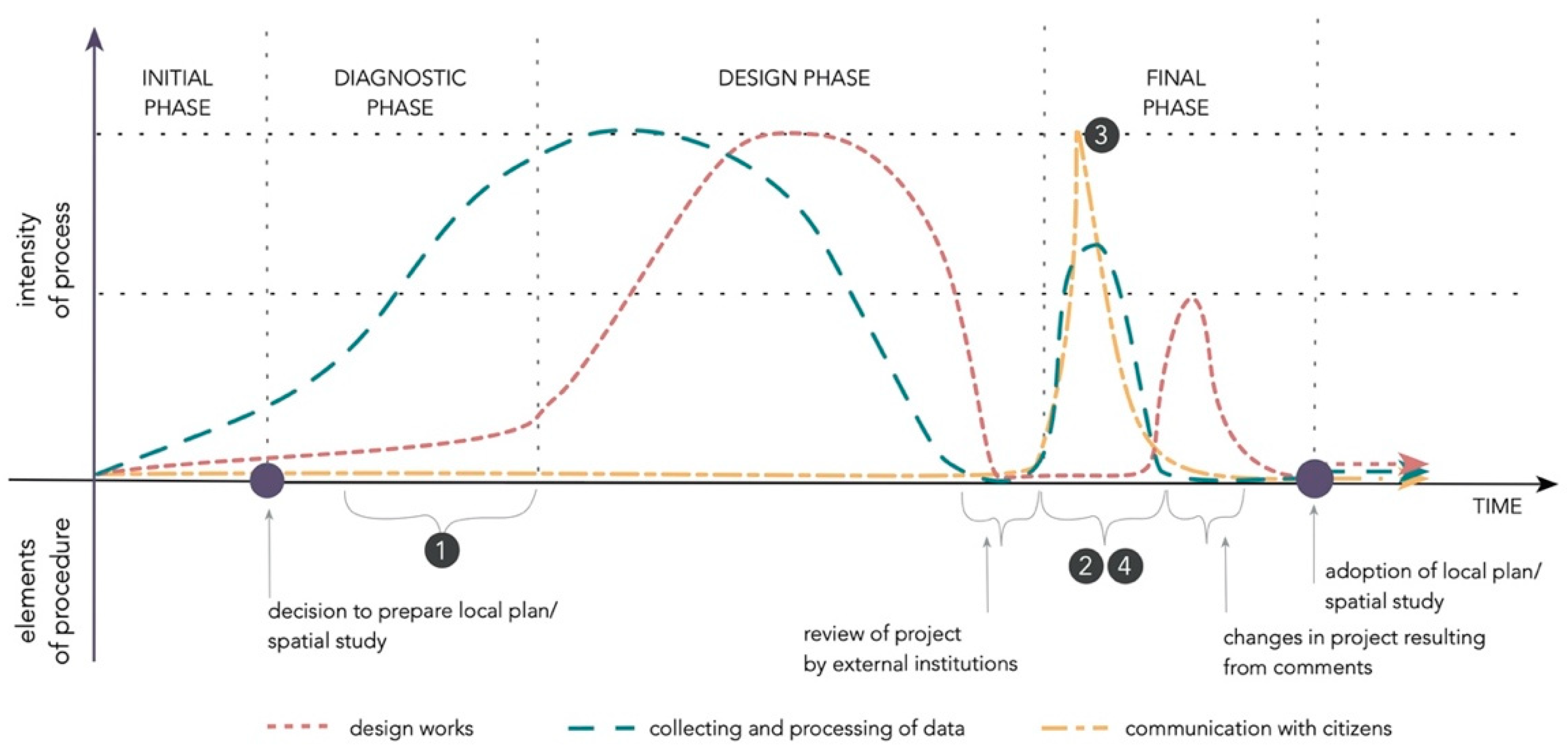

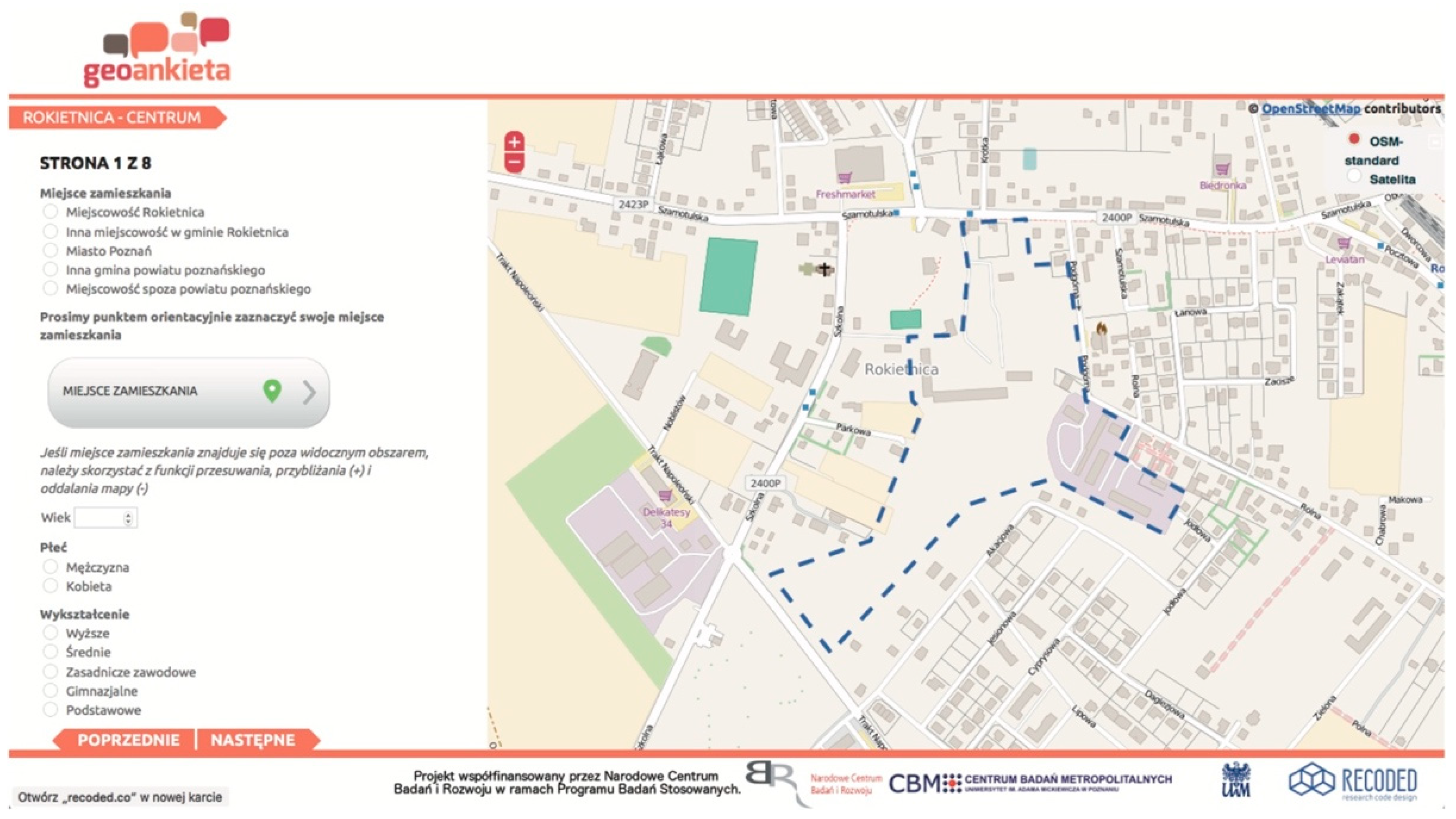
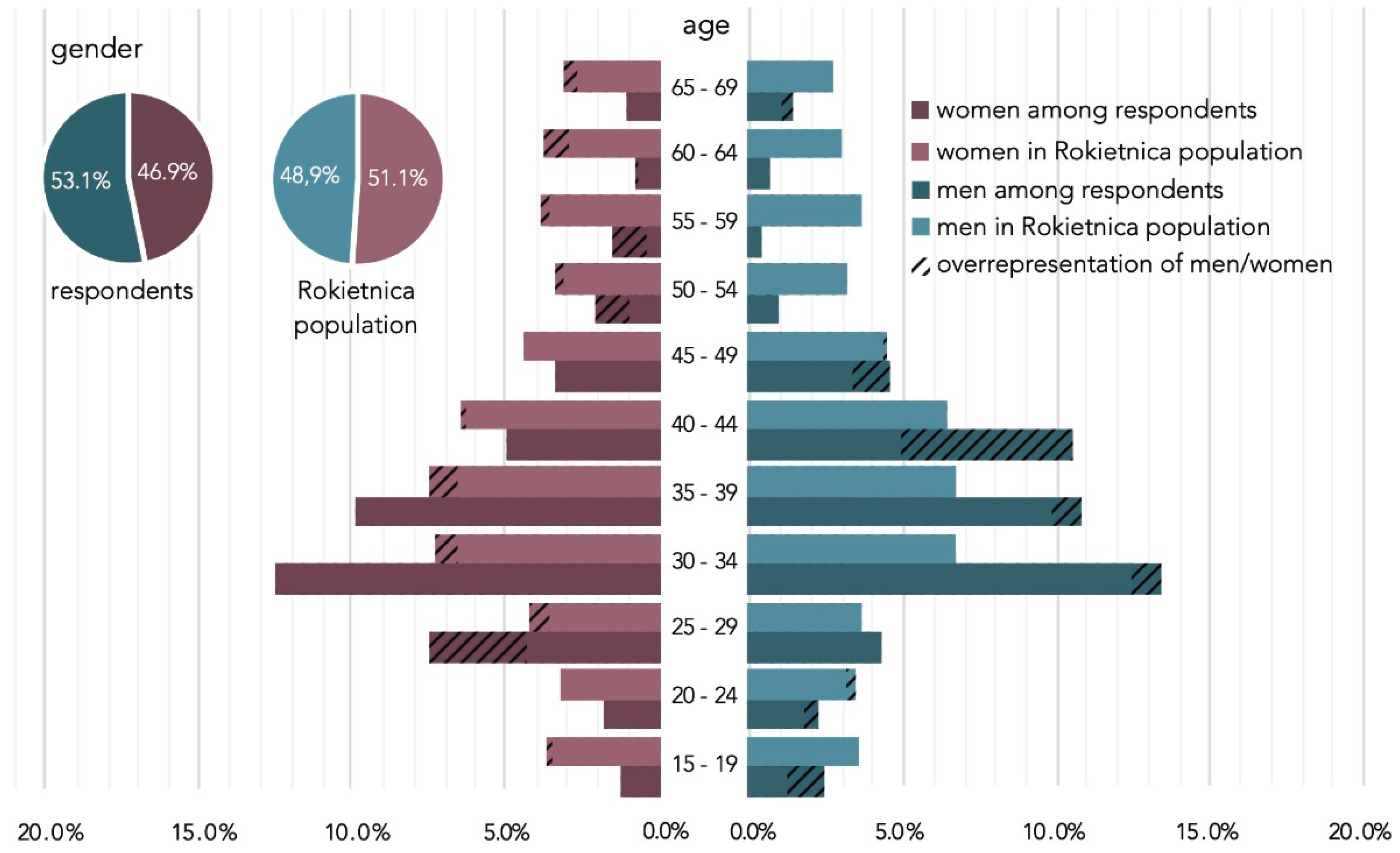
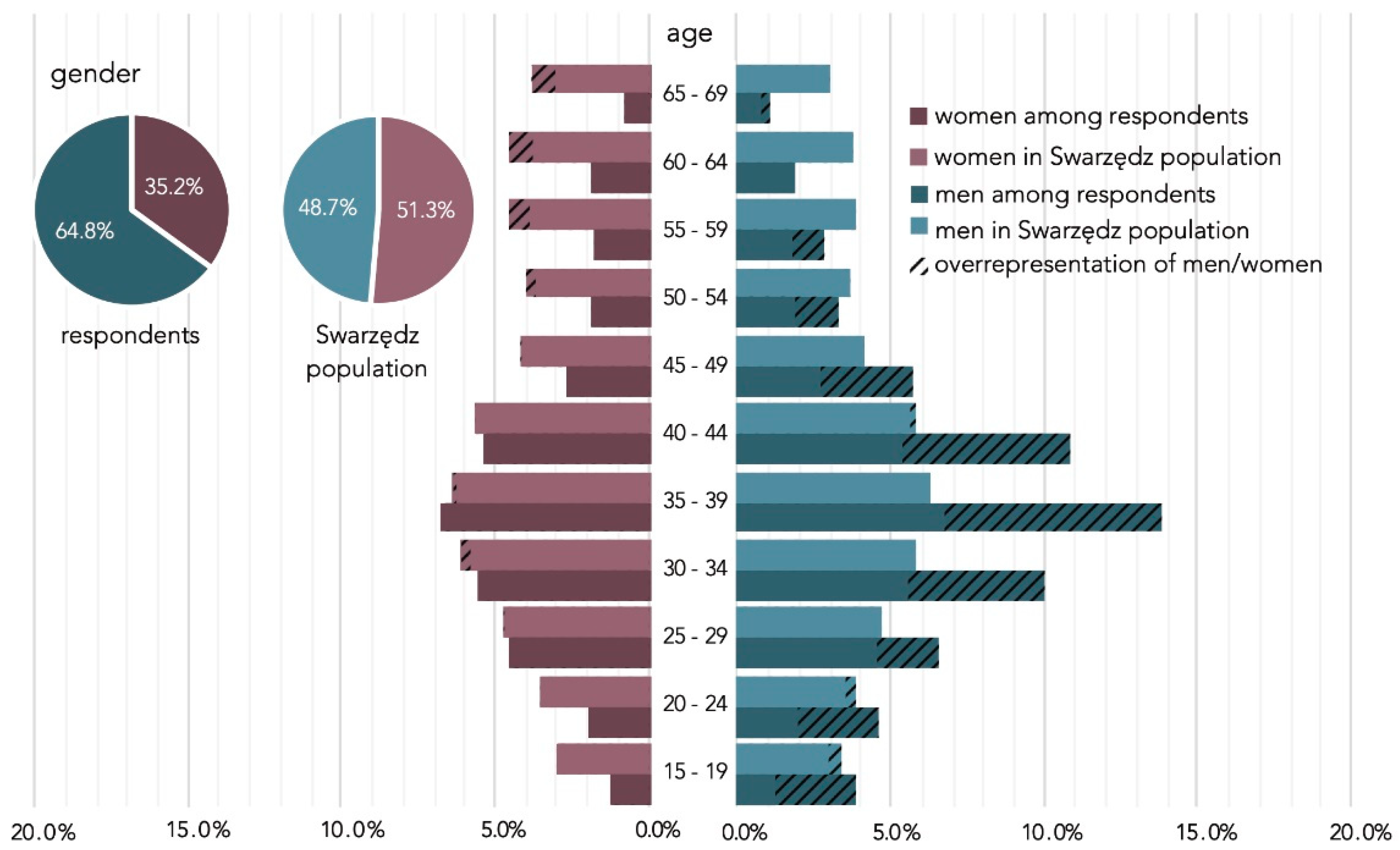


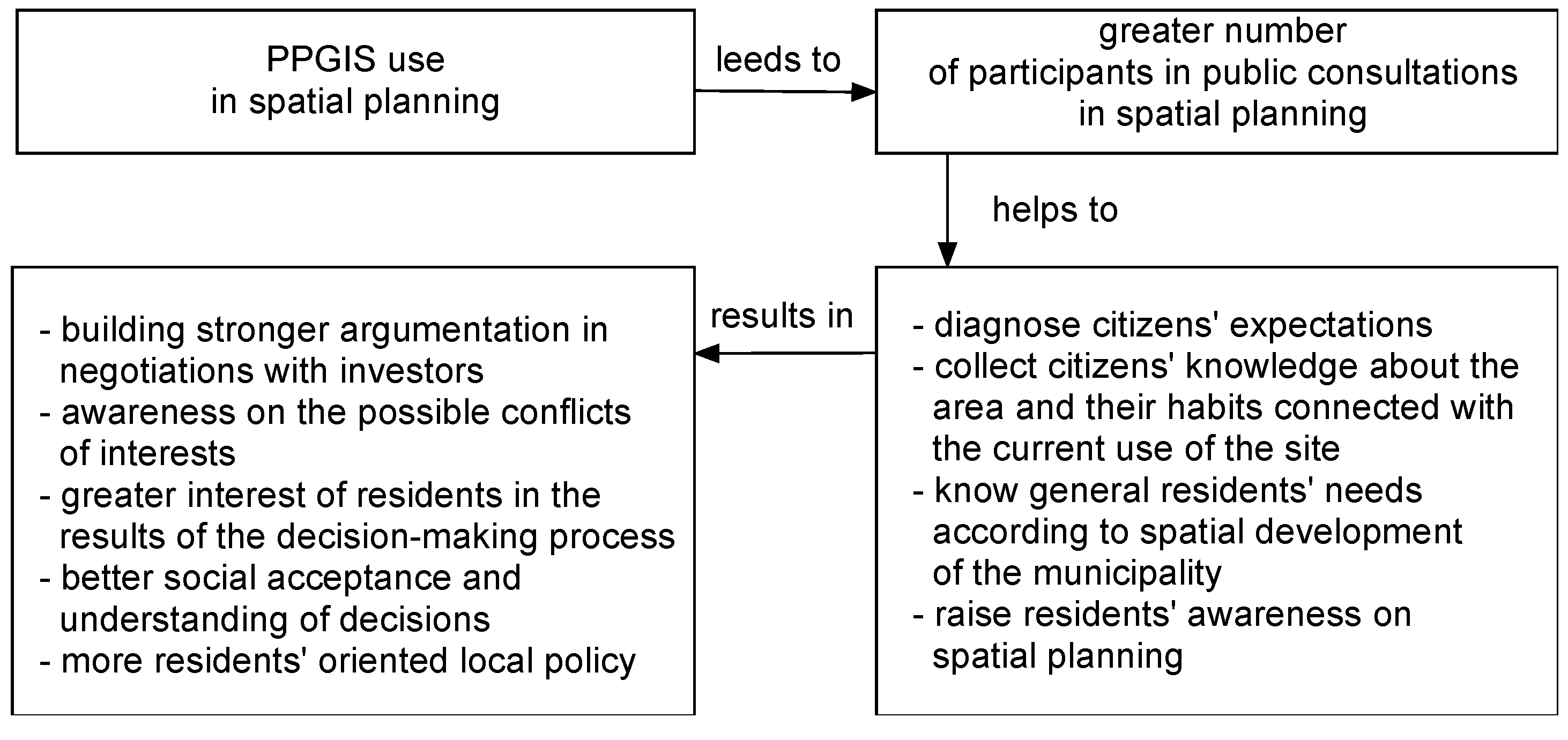
| Legal Documents | Graphic Materials | Other Materials |
|---|---|---|
| resolutions on the preparation of local spatial development plans | draft designs provided by urban planners | protocols from commune councils’ sessions |
| local spatial development plans (text and graphic appendix) | official design concepts presented by local authorities | media information |
| ID | Name | Area Covered by Consultations | Duration of Process | Number of Respondents | Number of Residents at Age of 15–69 * | Turnout ** |
|---|---|---|---|---|---|---|
| CS1 | New Center of Rokietnica | 16.0 ha | 2015–2021 | 482 (1st stage) and 163 (2nd stage) | 11,430 | 4.2% (1st stage), 1.4% (2nd stage) |
| CS2 | Land-use change of sports airport area Poznań–Kobylnica in Swarzędz | 150.0 ha | 2016–ongoing | 933 | 36,263 | 2.5% |
| ID | Input Development State—At the Beginning of the Process | Precedent Regulations in Spatial Study |
|---|---|---|
| CS1 | Brownfields after former food cooperative, fallow land, ruined buildings, wild greenery | Multi-family and single-family housing, services |
| CS2 | Sports airport, headquarter of sport aviation club, wild greenery | Mono-functional land use—airport |
| Feature | Goal | Development Details |
|---|---|---|
| Pre-planning local authority’s assumptions | Development of representative and functional center of commune. | Land use: residential (multi-family housing) with services and green areas, central area with public square, marketplace, administrative buildings and commercial buildings; Number of stories: up to 5 stories; Communication system: roads with preferences for cars; Parking lots: surface, underground garages; Trade and services: open air market, premises on ground floor of buildings. |
| Residents’ expectations | Development of widely accessible space with low density residential buildings, public green and recreational spaces, preferences for pedestrians. | Land use: residential (single- and multi-family housing) and services with green areas and outdoor recreational infrastructure; Central area with public square, cultural and administrative buildings; Number of stories: up to 3 stories; Communication system: roads with reduced traffic, preferences for pedestrians, bicycle lanes; Parking lots: surface, underground garages, no ground garages; Trade and services: stands or market hall, premises on the ground floor of buildings. |
| Property owners’ expectations | Development of profitable high-density multi-family estate. | Land use: residential (multi-family housing) and services; Number of stories: up to 6 stories; Communication system: preferences for car traffic; Parking lots: surface, underground garages; Trade and services: no information. |
| Decision-making output (local spatial development plan) | Balanced development of new center in place of brownfield with reduction in extra costs for commune for reduction of private land value. | Land use: residential (multi-family housing), services and public spaces (green areas, outdoor sport’s area). Administrative and cultural as optional; Number of stories: up to 5 stories; Communication system: preferences for car traffic; Parking lots: surface, underground garages; Trade and services: stands or market hall, premises on ground floor of buildings. |
| Feature | Goal | Development Details |
|---|---|---|
| Pre-planning local authority’s assumptions | Blocking investors’ plans to introduce warehouses and production in area. | Land use: different than warehouses or production; Number of stories: not specified; Communication system: not specified; Trade and services: not specified. |
| Residents’ expectations | Development of low-density residential area with greenery and recreation. | Land use: residential, single-family housing estate with greenery and recreation; Number of stories: up to 2; Communication system: connection of nearest estates and construction of collision-free railway crossings; Trade and services: as additional function. |
| Property owners’ expectations | Development of functions interesting for potential investor—warehouses or production. | Land use: warehouses and production function; Number of stories: not specified; Communication system: not specified; Trade and services: no. |
| Decision-making output (concept of local spatial development plan) | Development of area so that it is accepted by investors; however, excluding warehouses and production functions. | Land use: high-density multi-family housing with services; Number of stories: admission of high-rise buildings; Communication system: communication system limited only to servicing estate with one access road; Trade and services: not specified. |
Publisher’s Note: MDPI stays neutral with regard to jurisdictional claims in published maps and institutional affiliations. |
© 2021 by the authors. Licensee MDPI, Basel, Switzerland. This article is an open access article distributed under the terms and conditions of the Creative Commons Attribution (CC BY) license (https://creativecommons.org/licenses/by/4.0/).
Share and Cite
Bąkowska-Waldmann, E.; Kaczmarek, T. The Use of PPGIS: Towards Reaching a Meaningful Public Participation in Spatial Planning. ISPRS Int. J. Geo-Inf. 2021, 10, 581. https://doi.org/10.3390/ijgi10090581
Bąkowska-Waldmann E, Kaczmarek T. The Use of PPGIS: Towards Reaching a Meaningful Public Participation in Spatial Planning. ISPRS International Journal of Geo-Information. 2021; 10(9):581. https://doi.org/10.3390/ijgi10090581
Chicago/Turabian StyleBąkowska-Waldmann, Edyta, and Tomasz Kaczmarek. 2021. "The Use of PPGIS: Towards Reaching a Meaningful Public Participation in Spatial Planning" ISPRS International Journal of Geo-Information 10, no. 9: 581. https://doi.org/10.3390/ijgi10090581






